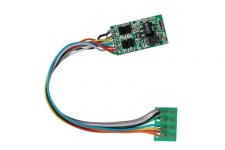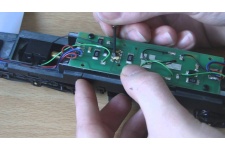Hornby R3682 BR, Princess Coronation Class, 4-6-2, 46225 'Duchess of Gloucester'
Designer: Sir William Stanier, Entered Service: 1938, Purpose: Express Passenger, Wheel Configuration: 4-6-2
Length: 301mm, Minimum Curve: 2nd Radius +(438mm), Motor: 5 Pole Skew Wound
The story of the Princess Coronation Class is one of split personalities and purposes and represents the difference in opinions and attitudes between design on the one hand, and perceived cost savings on the other.
The original streamlined form of the class arose from tests by the London Midland Scottish Railway’s Research Department on Stanier’s development of the Princess Royal class locomotives. Stanier was said to be ambivalent about the economic value of streamlining but was aware of the publicity value of such a design. When the opportunity to produce five conventional versions of the Coronation Pacific as a comparison to the streamlined version arose, Stanier was quoted as saying, “They can have their streamliners if they b***** want them, but we will also build them five proper ones”.
Those first five conventional locomotives were 6230 Duchess of Buccleuch to 6234 Duchess of Abercorn and colloquially they were known as Duchesses, after the first of this sub-class. Appearing in 1938 with a single chimney and without smoke deflectors, it is this form that many purists regard as the finest Pacific locomotive produced. The next four Duchesses to appear were 6249-6252 in 1944 and they emerged from works with a double chimney. Originally ordered as streamlined, the demands of maintaining the streamlined form exceeded the cost savings in coal and so they emerged from works without the casing, but with streamlined tenders (which had been completed before that decision was taken). In 1946 the next three Duchesses, 6253-6255, differed in appearance again, this time the curved fall plate at the front was replaced by a split platform and smoke deflectors were fitted. The final ‘as new’ produced Duchesses were 6256 and 46257 (as it appeared straight into British Railways ownership) and these were modified designs by Ivatt, featuring a different cab, pony truck, reversing gear and roller bearings.
The process of de-streamlining (or defrocking as the fitters called it) the remaining engines began with 6235 City of Birmingham in April 1946, with 6243 City of Lancaster being the last in May 1949. Because the smokeboxes were angled down between the chimney and door to accommodate the sweep of the streamlined casing, upon defrocking they retained this look, being referred to as semi-streamlined by enthusiasts of the time. Eventually the raked smokeboxes were replaced with conventional smokeboxes, so that by late 1958 the majority of the fleet showed a similar appearance, although all the defrocked locomotives had the split platform ‘utility’ front end.
Withdrawal of the class commenced in December 1962 and by October 1964 all had been withdrawn. Fortunately, three locomotives were saved for preservation; 6229 Duchess of Hamilton, 6233 Duchess of Sutherland and 6235 City of Birmingham.
46225 Duchess of Gloucester was built streamlined at Crewe and entered traffic at Camden on May 21, 1938, paired with tender 9743. The streamlined casing was removed on March 24, 1947 whilst the locomotive was allocated to Crewe North, although it had already spent time at Holyhead and Polmadie, as well as Camden and Crewe. Between January 22 and June 4, 1955, Duchess of Gloucester was the subject of drawbar power tests conducted by British Railways on the Settle & Carlisle line, as well as at Rugby Testing Station; tests that have been taken as confirmation that the Princess Coronation class were the most powerful British steam locomotives.
Please Note: Steam pipes fitted for display only. Various detail components can be customer fitted, including the drain cocks. Please be aware that you should not permanently fit any parts until you are certain that there will be no fouling during use. Depending on layout configuration some detail components are only suitable for fitting if the model is on static display.



